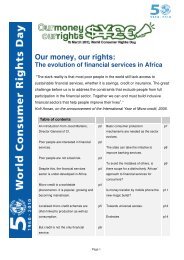Voices for Change: the Consumer Right to Representation
Voices for Change: the Consumer Right to Representation
Voices for Change: the Consumer Right to Representation
Create successful ePaper yourself
Turn your PDF publications into a flip-book with our unique Google optimized e-Paper software.
World <strong>Consumer</strong> <strong>Right</strong>s Day 2002: <strong>Voices</strong> <strong>for</strong> <strong>Change</strong><br />
3 Models of <strong>Representation</strong><br />
and Consultation<br />
In practice, consumers exercise <strong>the</strong>ir “right<br />
<strong>to</strong> be heard” in many different ways. How<br />
should we describe <strong>the</strong> various systems of<br />
representation? What can we say about<br />
<strong>the</strong>ir advantages and disadvantages? In<br />
this chapter, Colin Brown evaluates<br />
different systems and institutions set<br />
up <strong>for</strong> decision-makers <strong>to</strong> hear <strong>the</strong><br />
consumer voice.<br />
The crucial element in <strong>the</strong> definition of<br />
consumer representation is that <strong>the</strong> decisionmaker<br />
acknowledges <strong>the</strong> consumer’s right <strong>to</strong><br />
be heard – and has a system <strong>for</strong> listening.<br />
There are many mechanisms employed by<br />
governments, public bodies, industry and<br />
trade bodies <strong>for</strong> <strong>the</strong> consultation,<br />
representation and participation of consumers.<br />
Hearing <strong>the</strong> consumer<br />
The “consumer voice” can mean different<br />
things <strong>to</strong> different people. This is reflected in<br />
<strong>the</strong> various institutional arrangements <strong>for</strong><br />
representation and consultation. The consumer<br />
voice can mean <strong>the</strong> opinions and views of<br />
ordinary consumers, or it can mean an<br />
articulation of <strong>the</strong> consumer interest, typically<br />
expressed by consumer organisations.<br />
Listening <strong>to</strong> consumers can mean taking note<br />
of <strong>the</strong>ir needs, or <strong>the</strong>ir preferences and desires,<br />
or <strong>the</strong>ir habits and behaviour. These different<br />
voices are sometimes in tune with each o<strong>the</strong>r,<br />
and sometimes not.<br />
Which of <strong>the</strong>se voices is heard depends partly<br />
on what consumer representation is intended<br />
<strong>to</strong> achieve. Different aims can lead <strong>to</strong> different<br />
practical approaches. In <strong>the</strong> consumer<br />
movement, we tend <strong>to</strong> see consumer<br />
representation as a way of “balancing <strong>the</strong><br />
scales” – as a counterweight <strong>to</strong> <strong>the</strong> power of<br />
producers and suppliers. In some<br />
circumstances, we also see representation as a<br />
mechanism <strong>for</strong> resolving individual consumer<br />
problems and complaints. O<strong>the</strong>rs see <strong>the</strong> aim<br />
of consumer representation as contributing <strong>to</strong><br />
plural democracy, with <strong>the</strong> organised<br />
consumer voice being heard alongside many<br />
o<strong>the</strong>r interest groups, including o<strong>the</strong>r nongovernmental<br />
organisations (NGOs) such as<br />
sec<strong>to</strong>ral charities, self-help groups,<br />
development organisations and environment<br />
groups. A very different view is that <strong>the</strong> aim of<br />
consultation and representation is <strong>to</strong> connect<br />
decision-makers directly with ordinary people<br />
speaking <strong>for</strong> <strong>the</strong>mselves, <strong>to</strong> achieve a closer<br />
democratic engagement between <strong>the</strong> public<br />
and policy-making. An underlying aim, shared<br />
by all of <strong>the</strong>se perspectives, is <strong>to</strong> produce<br />
better policy and better outcomes by getting<br />
decision-makers <strong>to</strong> take consumer needs<br />
in<strong>to</strong> account.<br />
Speaking <strong>for</strong> o<strong>the</strong>rs?<br />
In practice, <strong>the</strong>re is no best model <strong>for</strong> <strong>the</strong><br />
right <strong>to</strong> be heard. Different systems of<br />
representation and consultation deliver<br />
different aspects of <strong>the</strong> consumer voice. One<br />
important consideration is whe<strong>the</strong>r consumers<br />
are heard via representatives (whose job is <strong>to</strong><br />
argue <strong>the</strong> consumer interest and relay<br />
consumer views) or whe<strong>the</strong>r ordinary<br />
consumers are invited <strong>to</strong> speak <strong>for</strong> <strong>the</strong>mselves.<br />
Often, because of <strong>the</strong>ir connections with<br />
consumer organisations, representatives are<br />
well-equipped <strong>to</strong> present a considered view of<br />
17






![pkef]Qmf eg]sf] s] xf] < - Consumers International](https://img.yumpu.com/6479658/1/184x260/pkefqmf-egsf-s-xf-consumers-international.jpg?quality=85)
